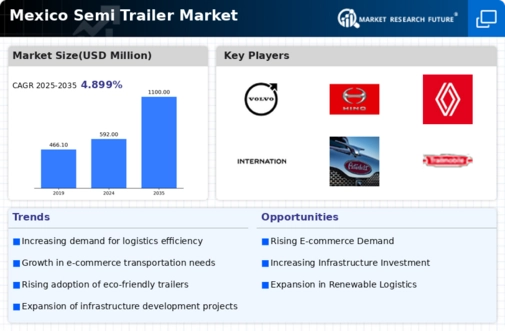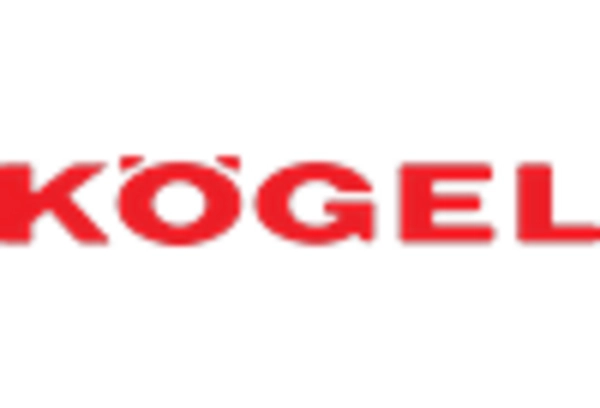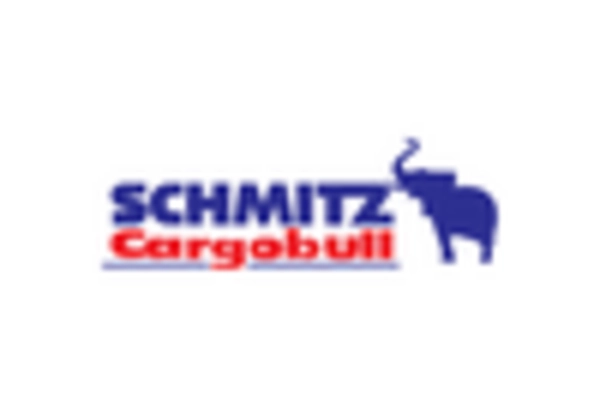Infrastructure Development Initiatives
Infrastructure development initiatives in Mexico play a crucial role in shaping the semi trailer market. The government has been investing heavily in road networks and transportation facilities, which directly impacts the efficiency of freight movement. In 2025, it is estimated that infrastructure spending will reach $10 billion, aimed at improving highways and logistics hubs. This investment not only enhances connectivity but also reduces transit times, making semi trailers a more attractive option for transporters. As infrastructure improves, the semi trailer market is likely to benefit from increased adoption rates, as companies seek to capitalize on the enhanced logistics capabilities. The synergy between infrastructure development and the semi trailer market is expected to drive growth and innovation.
Rising Fuel Prices and Efficiency Demands
Rising fuel prices in Mexico are compelling logistics companies to seek more fuel-efficient solutions, thereby impacting the semi trailer market. In 2025, fuel costs are projected to increase by 8%, prompting transporters to prioritize fuel efficiency in their operations. This trend is likely to drive demand for semi trailers equipped with advanced aerodynamics and lightweight materials, which can significantly reduce fuel consumption. The semi trailer market is thus responding to these efficiency demands by innovating and offering products that align with the need for cost-effective transportation solutions. As fuel prices continue to fluctuate, the emphasis on efficiency will remain a critical driver for the semi trailer market.
Growth of E-commerce and Last-Mile Delivery
The growth of e-commerce in Mexico is reshaping the logistics landscape, significantly impacting the semi trailer market. As online shopping continues to gain traction, the demand for efficient last-mile delivery solutions is increasing. In 2025, e-commerce sales are expected to reach $30 billion, necessitating a robust logistics framework to support this growth. Semi trailers are becoming essential for transporting goods to distribution centers, where they can be further dispatched for last-mile delivery. The semi trailer market is thus positioned to benefit from this trend, as logistics companies invest in their fleets to meet the rising demands of e-commerce. The interplay between e-commerce growth and the semi trailer market is likely to drive innovation and expansion.
Increasing Demand for Freight Transportation
The semi trailer market in Mexico experiences a notable surge in demand for freight transportation, driven by the country's expanding economy and growing trade activities. As Mexico strengthens its position as a manufacturing hub, the need for efficient logistics solutions becomes paramount. In 2025, the freight transportation sector is projected to grow by approximately 6.5%, indicating a robust market for semi trailers. This growth is further fueled by the rise in e-commerce, which necessitates reliable delivery systems. Consequently, logistics companies are increasingly investing in semi trailers to enhance their operational efficiency and meet customer expectations. The semi trailer market is thus poised for significant growth as businesses adapt to the evolving landscape of freight transportation.
Regulatory Changes and Compliance Requirements
Regulatory changes in Mexico are influencing the semi trailer market, as the government implements stricter compliance requirements for transportation safety and emissions. In 2025, new regulations are expected to mandate the use of advanced safety features in semi trailers, which could lead to increased costs for manufacturers and operators. However, these regulations also present opportunities for innovation within the semi trailer market, as companies develop new technologies to meet compliance standards. The potential for increased operational costs may drive some businesses to upgrade their fleets, thereby stimulating demand for modern semi trailers. As the regulatory landscape evolves, the semi trailer market must adapt to ensure compliance while maintaining competitiveness.

















Leave a Comment